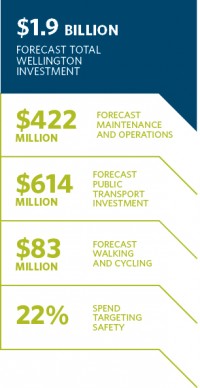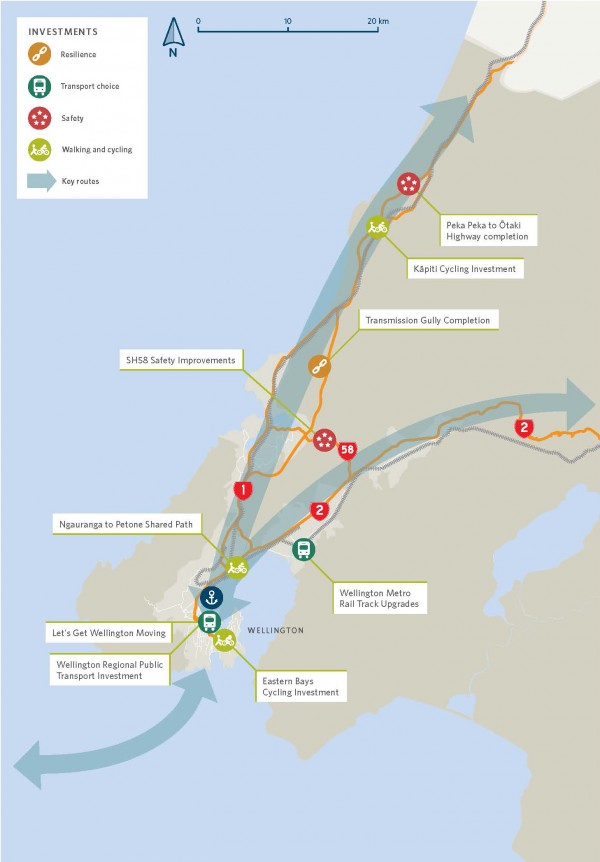
The Wellington region’s transport challenges are dominated by the region’s concentration of population in the metropolitan cities, its importance as the nation’s capital, constrained access corridors along SH1 and SH2 and the significant economic role its port plays to connect the North and South Islands.
Wellington's constrained corridors to and from community and economic centres in Kāpiti, the Hutt Valley, Wairarapa and beyond have shaped the region’s transport network. The region relies on two north-south transport corridors that include road and rail.
Key urban centres throughout the region - central Wellington city has the highest concentration of employment in New Zealand - are at risk of becoming isolated in a major event such as a severe earthquake, storms, serious crashes and rising sea levels. There is limited east-west connectivity, few alternative routes and the main rail and road corridors are close to each other.
The region’s transport system is notable for its multi-modal nature. There is an almost even split between driving and other modes of transport entering the Wellington CBD at peak commuting times. While about half of morning commuters drive, nearly 40 percent take the train and the remaining 10 percent use the bus, or cycle or walk.
The more than 82,000 people traveling to or through the Wellington CBD each day create a significant commuter peak both on road and public transport networks. In recent years, weekend peaks have also developed around the middle of the day on Saturday and Sunday. Congestion pressure in Wellington city is further exacerbated by the need to traverse the CBD to reach key facilities, such as the city’s main hospital and its airport.
The Transport Agency will continue working with its Let’s Get Wellington Moving partners to further investigate and deliver the best transport solutions to benefit the city and the wider region.
The road network has a number of pinch points, including the Ngauranga Gorge interchange. A lack of alternative routes limits the capacity and resilience of the network, particularly at peak times.
The Transport Agency will invest in an intelligent transport system (ITS) improvement programme to provide people with near real-time information to help them plan safe and efficient journeys. It will also invest in interim measures on SH1 from Tawa through to the Wellington CBD, to ensure that people and goods can get where they need to be, reliably and safely.
The region’s projected population growth adds to the challenges facing its land transport system. About 40 percent of people live in Wellington city. Wellington’s CBD will remain the fastest growing residential area in the region with the population expected to nearly double over the next 20 years. However, Wellington’s northern suburbs, Porirua, and north of Waikanae on the Kāpiti Coast, will continue to grow, as will Hutt City but at a slower rate.
As the home of central government, Wellington city’s economy is dominated by public administration and services. Nearly 60 percent of the region’s jobs are located in the city, with 60 percent of those jobs concentrated in the CBD.
Hutt City is the second largest employment centre. As transport connections to Porirua and Kāpiti improve, service and commercial industries in those locations are expected to grow. In Wairarapa, agriculture, forestry and viticulture are the main economic drivers with tourism growing in importance.
Nationally, the region will continue to play an important transportation role in connecting the North and South Islands. The inter-island ferry services in Wellington provides a critical road/rail link for passengers and freight. Wellington airport, the country’s third busiest airport, is expected to see strong growth in passenger numbers.
 Improving network resilience
Improving network resilienceDisruption to the transport system has social and economic impacts. Parts of the Wellington region are at risk from isolation in a major event. The Transport Agency’s plans to improve resilience include:
Expanded public transport services will improve access to education, healthcare, employment and training opportunities. Priorities in the Wellington region include:
In Wellington, more people walk or cycle to work compared to the national average. Around 80 percent of people living in the CBD walk to work. Wellington’s focus is on providing greater transport choice using an integrated transport approach that encourages more people to walk or cycle.
The Transport Agency expects to invest $83m in walking and cycling in the Wellington region with the following priorities:
The Transport Agency and ACC have developed a national cycling education system to increase the reach of cycling education in New Zealand.
Since 2007, the region has seen a steady decline in the number of people killed or injured in crashes. Targeting high-risk crash areas, installing central median barriers in high-speed environments and improved vehicle safety standards contribute to this trend.
The Transport Agency will invest in speed management and other safety measures to further reduce deaths and serious injuries.
SH2 is the primary link between Wellington and rural Wairarapa and has a poor safety record, particularly for motorcyclists. Median and roadside barriers, intersection improvements and speed management will be used along the corridor to improve safety.
SH58 connects SH1 and SH2 and has a poor safety record in the region. A package of safety improvements for SH58 is moving into the construction stage. The improvements include two new roundabouts and median and roadside safety barriers.
The Transport Agency is investing in the Weigh Right programme and will replace the weigh station on SH1 at Plimmerton. It will also work with the freight industry to reduce heavy vehicle overloading, which will improve road safety and reduce long-term road maintenance needs.
The Transport Agency will build on its good environmental practices to better manage any adverse environmental effects of the state highway network. The Transport Agency’s national programme to replace all state highway lighting with more cost effective LED lighting to save costs on power and maintenance will be accelerated across the region.
Three projects in the Wellington region are being re-evaluated to determine alignment with the new Government Policy Statement on land transport (GPS). These include Ōtaki to North of Levin, SH2 (River Link) Melling transport improvements and the Petone to Grenada Link Road.
The following projects already in construction will continue:
Transmission Gully.
Peka Peka to Ōtaki Expressway.
SH1 Mackays to Peka Peka Expressway (remediation works and reducing road noise).
Keeping land transport networks available for people to get where they want to go easily, reliably and safely is a primary objective of transport investment within the region and beyond. Over the 2018-21 period, local roads will receive $332m and state highways $759m for maintenance and improvements.
The Transport Agency will fund low cost, low risk investments that target the Government’s desired outcomes as set out in the GPS. Examples include improvements to specific intersections, traffic calming measures, improvements to lighting to increase safety, and walking and cycling facilities.